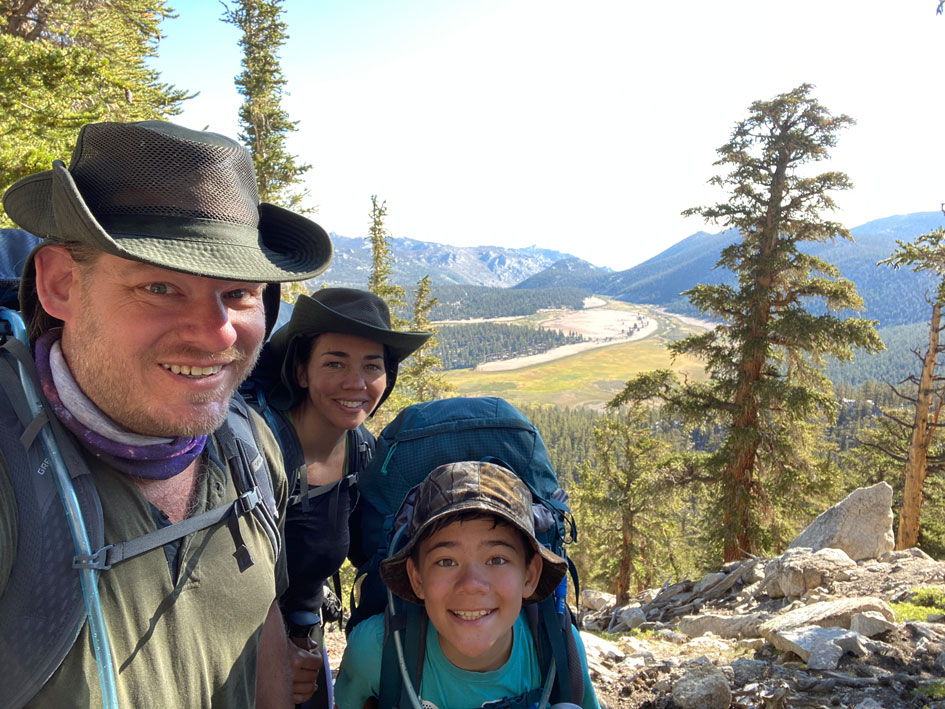 Below are the requirements I completed for the Backpacking Badge
Below are the requirements I completed for the Backpacking Badge
Note: Click any image on this page to enlarge it in a new tab
|
“Complete one 2-mile hike with a full backpack.”
We hiked the PCT from the dam spillway to 3.5 miles up Deep Creek. We were going to complete a 15-mile backpacking trip, but we lost the trail and decided to explore, camp, and swim along the river instead. This was our first experience losing a trail and the going was rocky and difficult.
5/29/2020-5/31/2020 |
 |
|
“Complete three 15-mile, 3-day backpacking trips.”
#1 of 3
This was the first of the three, from Echo Lake to Lake Aloha and back. We camped at Lake Aloha the first night, and camped about halfway back on the second night. On this trip, we swam in a lake surrounded by snow, experienced extreme mosquito attacks and got to use our mosquito netting!
6/18/2020-6/20/2020 |
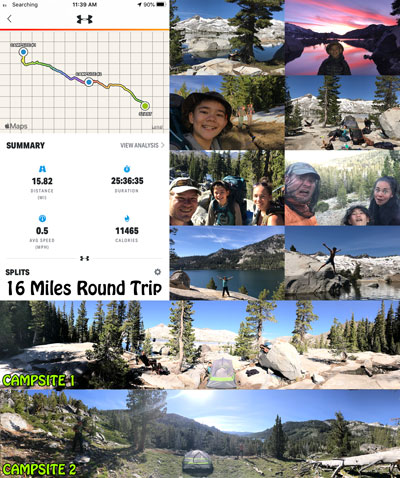 |
|
“Complete three 15-mile, 3-day backpacking trips.”
#2 of 3
We hiked to the Kennedy Meadow Bridge and beyond via the PCT. On the first day, we hiked 9 miles, a record for us with our packs. We hiked 7.5 miles to a stream, but it turned out to be dry, so we hiked back a mile and a half and found a small water source and a nice camping spot. The next day we hiked downhill all day back to the bridge and camped a short ways upstream from the bridge.
7/9/2020-7/11/2020 |
 |
|
“Complete three 15-mile, 3-day backpacking trips.”
#3 of 3
We hiked to the Deep Creek Hot Springs and back. This trip was about hiking and swimming. On our first day, we hiked 7.5 miles to the Hot Springs, swimming under the bridge and at the Hot Springs. On the second day, we hiked a little over halfway back and camped by the river. We swam and had seaweed fights all evening. The next morning, we swam some more and then hiked out!
7/22/2020-7/24/2020 |
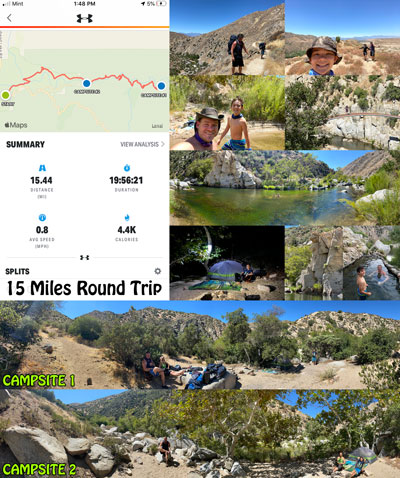 |
|
“Plan a 30-mile, 5+ day, and using three or more campsites trip, and complete it. Your plan must include a description of and route to the trek area, a schedule (including a daily schedule), a list of food and equipment needs, a safety and emergency plan, and a budget.” |
|
We hiked the Cottonwood Lakes Loop. Our first day, we hiked 9 miles to a lake, but we decided to camp about 300 feet back for a better view. The next day, we hiked 6 miles to Cottonwood Lake #4 and prepared to hike a 1,200 foot elevation. The day after that, we hiked up 1,200 feet of elevation on Old Army Pass and continued on for 8 more miles. Our second-to-last day, we hiked 5 more miles and camped on a hill with an amazing view. On our final day, we hiked 6.5 miles out.
8/10/2020-8/15/2020 |
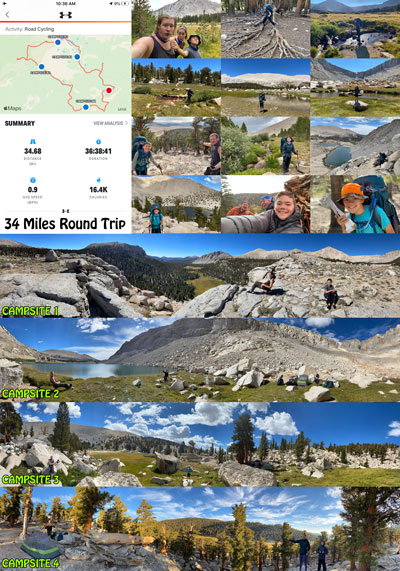 |
|
Extra Credit Backpacking Trip #1
We decided to hike the Deep Creek Hot Springs trail to camp on the river because the day was going to reach 106° F. We hiked about halfway to the Hot Springs to find a site we had seen before, but when we arrived, we couldn’t find a shady spot to put our tent, so we napped and swam for a bit. After the heat had died down, we hiked about a mile back to a place we had camped before and stayed the night there. We then hiked out at around 6 o’ clock the next day.
6/17/2021-6/18/2021 |
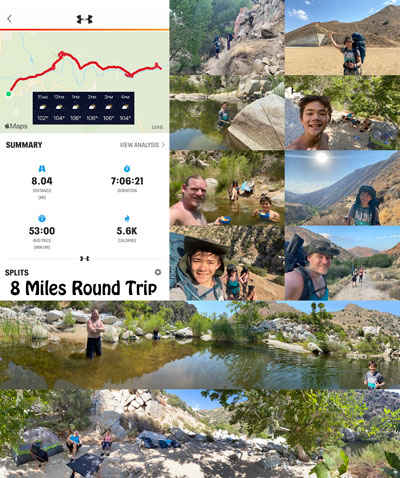 |
|
Extra Credit Backpacking Trip #2
We backpacked to the Cedar Glen Campground to meet up with some friends. We thought the trail was 2.2 miles but when we got there, it turned out to be more than 3 miles.
7/2/2021-7/3/2021 |
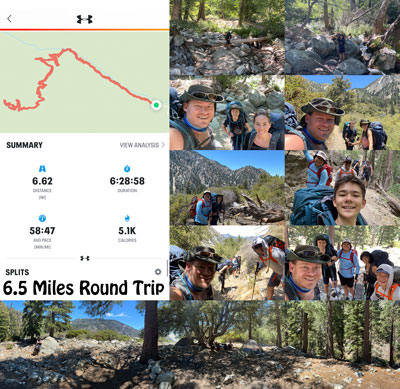 |
|
Extra Credit Backpacking Trip #3
We backpacked up from Mineral King to Eagle Lake. The 4-mile hike in was almost completely uphill, totaling just over 2000 feet of elevation. We had to cover our car with a tarp to protect it from what the rangers called the “Marmot Menace.” During the hike up, we walked by a few beautiful waterfalls and got some amazing pictures. We also saw 4 different deer, one of which walked within 10 feet of us!
7/13/2021-7/14/2021 |
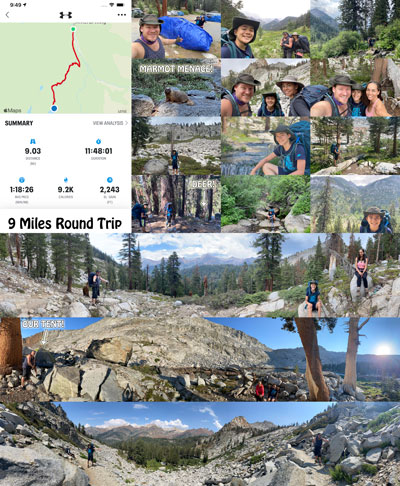 |
|
Extra Credit Backpacking Trip #4
We backpacked up to the Thousand Islands Lake on the River Trail. On the first day, we hiked 4 miles up and camped on a beautiful ridge. The next day, we hiked up the rest of the 4.5 miles to get to the lake. We hiked up a small hill and camped at the top to get some breathtaking views. On the last day, we hiked out in just about 7 hours, even with a bunch of breaks. One of the cool things about this hike was the diverse ecosystems we found along the way. Additionally, the weather was perfect, as when we were hiking up, we had shade and light rain for most of the hikes, but downhill we had a perfect mix of sun and shade.
8/12/2021-8/14/2021 |
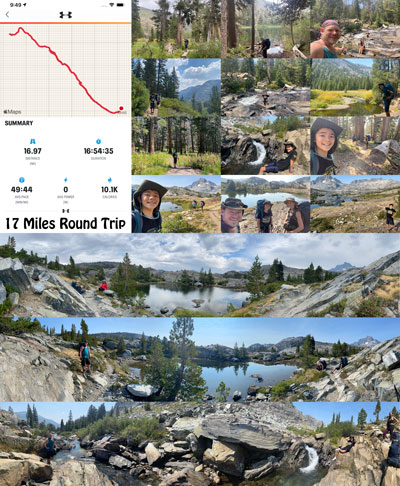 |
|
Extra Credit Backpacking Trip #5
This time, we backpacked up Half Dome as part of our vacation in Yosemite. In order to save our legs from hiking the hardest parts of the hike with big backpacks, we camped a couple of miles below the base of Half Dome. We then got up early the next morning and finished the hike without packs. Once we finally got to the top, we were able to see the beautiful sweeping views! We admired the views and took pictures for about an hour, then hiked down, took a recovery nap, and hiked out. About half of our hike out was in the dark, and we didn’t get back down until around 10 P.M.
10/8/2021-10/9/2021 |
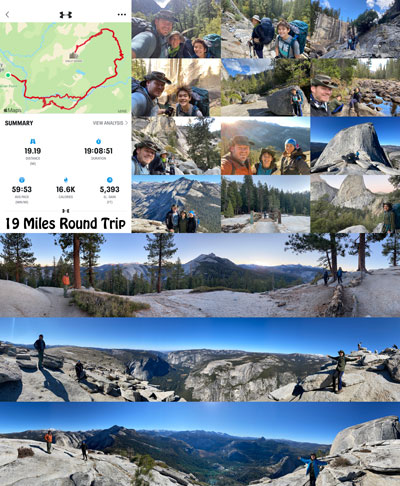 |
|
Extra Credit Backpacking Trip #6
For this trip, we chose to do a single night along the San Gabriel River West Fork Trail. We didn’t have a planned campsite, and after 2 years off of backpacking, we were ready to camp at 3 miles in. While hiking up, we found some delicious wild blackberries that we promptly ate. The next day, I made our breakfast and we broke camp early to pick extra blackberries along the river on the hike back, saving a few cups of blackberries to be eaten at home.
8/9/2023-8/10/2023 |
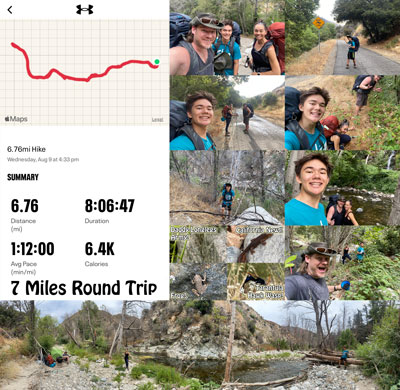 |
ADDITIONAL REQUIREMENTS COMPLETED
In addition to the above, I also researched all the following areas and then completed a verbal presentation/interview to demonstrate my knowledge and understanding for each of them:
Requirement: Explain the following…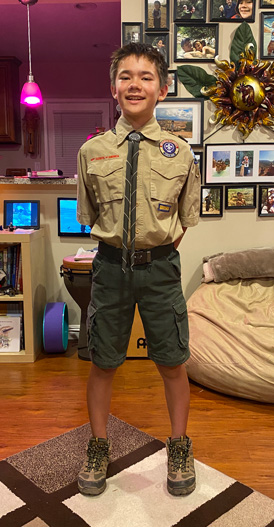
- Discuss the prevention of and treatment for the health concerns that could occur while backpacking, including hypothermia, heat reactions, frostbite, dehydration, insect stings, tick bites, snakebite, and blisters.
- List 10 items that are essential to be carried on any backpacking trek and explain why each item is necessary.
- Describe 10 ways you can limit the weight and bulk to be carried in your pack without jeopardizing your health or safety.
- Define limits on the number of backpackers appropriate for a trek crew.
- Describe how a trek crew should be organized.
- Tell how you would minimize risk on a backpacking trek.
- Explain the purpose of an emergency response plan.
- Describe the importance of using Leave No Trace principles while backpacking, and at least five ways you can lessen the crew’s impact on the environment.
- Describe proper methods of handling human and other wastes while on a backpacking trek. Describe the impor- tance of and means to assure personal cleanliness while on a backpacking trek.
- Tell what factors are important in choosing a campsite.
- Demonstrate two ways to treat water and tell why water treatment is essential.
- Explain to your counselor the importance of staying well-hydrated during a trek.
- Demonstrate that you can read topographic maps.
- While on a trek, use a map and compass to establish your position on the ground at three different locations OR use a GPS receiver to establish your position on a topographic map and on the ground at three different locations.
- Explain how to stay found, and what to do if you get lost.
- Tell how to properly prepare for and deal with inclement weather.
- Explain the advantages and disadvantages of the different types of backpacking stoves using at least three different types of fuel.
- Demonstrate that you know how to operate a backpacking stove safely and to handle fuel safely.
- Demonstrate that you know how to keep cooking and eating gear clean and sanitary, and that you practice proper methods for food storage while on a backpacking trek.
Doing pushups at Aloha Lake for my Personal Fitness Badge.
via GIPHY
 Below are the requirements I completed for the Backpacking Badge
Below are the requirements I completed for the Backpacking Badge











